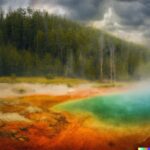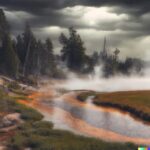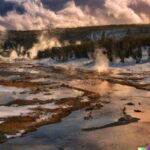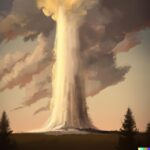Yellowstone National Park is home to some of the most stunning natural geothermal features on the planet, including hot springs and geysers. But what exactly are these fascinating phenomena? How are they formed, and what makes them so special?
In this article, we’ll explore the differences between hot springs and geysers, how they are formed, where you can find them in Yellowstone, and their unique characteristics. We’ll also discuss the ecological, geological, and recreational importance of these features, as well as the efforts being made to protect them within the park. So, let’s dive into the world of Yellowstone hot springs and geysers and discover their wonders!
What are Yellowstone Hot Springs and Geysers?
Yellowstone Hot Springs and Geysers are iconic thermal features located within Yellowstone National Park, showcasing the natural wonders resulting from volcanic activity.
These unique thermal features are a testament to the powerful forces at work beneath the Earth’s surface. The geysers, such as the famous Old Faithful, exhibit remarkable eruptions with scalding water reaching great heights.
The hot springs, on the other hand, display stunning, colorful mineral formations, created by the interaction between heated water and surrounding rocks. Their formation dates back to thousands of years, and they hold significant geological importance as windows into the Earth’s volcanic processes.
What is the Difference Between Hot Springs and Geysers?
Understanding the difference between Yellowstone Hot Springs and Geysers involves exploring their distinct features, attractions, and geological formations, which set them apart in terms of their thermal characteristics and eruptions.
How are Hot Springs Formed?
The formation of Yellowstone Hot Springs is intricately linked to geological processes and the heating of groundwater, resulting in varying water temperatures and the creation of captivating geological formations.
As the water percolates deep into the earth’s crust, it gets heated by the molten rock, known as magma, below the surface. This process, known as geothermal heating, causes the water to rise back to the surface, emerging as hot springs.
The varying temperatures of the springs result from different depths at which the water is heated. The unique geological formations at Yellowstone Hot Springs are further influenced by the deposition of minerals as the water travels through the earth, contributing to the colorful and captivating landscapes seen around the hot springs.
How are Geysers Formed?
Geysers in Yellowstone are formed through the interaction of water, volcanic heat sources, and the release of steam, leading to mesmerizing eruptions that distinguish them as spectacular hydrothermal features.
This process begins with groundwater percolating downward, reaching hot volcanic rocks and becoming heated. As the water’s temperature increases, it transforms into steam, building pressure beneath the Earth’s surface.
Eventually, the pressure becomes immense, causing the water to forcefully erupt in the form of a geyser. The distinctiveness of each geyser arises from variations in underground hydrothermal plumbing systems and the unique combination of minerals dissolved in the water, contributing to the stunning display of natural forces.
Where Can You Find Yellowstone Hot Springs and Geysers?
Yellowstone National Park stands as the premier location to witness the captivating beauty of its hot springs and geysers, making it a must-visit destination for nature enthusiasts and outdoor adventurers seeking remarkable hydrothermal phenomena.
What is the Location of Yellowstone National Park?
Yellowstone National Park, situated primarily in the U.S. state of Wyoming, encompasses diverse geological formations and landscapes, playing a pivotal role in understanding the environmental impact of natural wonders.
It is home to the famous Yellowstone Caldera, one of the largest volcanic systems in North America, and boasts more geysers than anywhere else on Earth, including the iconic Old Faithful. The park’s unique hydrothermal features, such as hot springs and mud pots, showcase the ongoing geologic activity that continuously shapes the landscape. This natural laboratory provides scientists with invaluable insights into the Earth’s processes and has significant implications for environmental conservation and research.
What are the Specific Areas to Find Hot Springs and Geysers in Yellowstone?
Yellowstone boasts specific areas such as the Upper Geyser Basin, Mammoth Hot Springs, and Norris Geyser Basin, where visitors can marvel at the enchanting beauty of hot springs and geysers. These areas offer unparalleled opportunities for sightseeing and outdoor adventures.
Located in Yellowstone National Park, these unique geological features attract visitors from all over the world. The famous Old Faithful geyser, the stunning terraces of Mammoth Hot Springs, and the bubbling thermal pools of Norris Geyser Basin are just some of the highlights. Nature enthusiasts, hikers, and wildlife photographers flock to these areas to experience the diverse landscapes and vibrant thermal activity of Yellowstone’s geothermal wonders.
What are the Characteristics of Yellowstone Hot Springs and Geysers?
The characteristics of Yellowstone Hot Springs and Geysers encompass a diverse range of elements, including their distinctive temperature, mesmerizing colors, and unique chemical composition, which contribute to their captivating allure as natural wonders.
Temperature
The temperature of Yellowstone Hot Springs and Geysers varies significantly, showcasing the mesmerizing geothermal phenomena that underlie their natural beauty and scientific significance.
Yellowstone National Park is home to a diverse array of hot springs and geysers, each with their own distinct water temperatures. Ranging from pleasantly warm to scalding hot, these geothermal features provide a unique habitat for specialized aquatic plants and animals.
The extreme temperatures are a result of their proximity to the Earth’s molten core, with some sources reaching a scorching 450°F (232°C). This intense heat causes the iconic bubbling and eruptions that make Yellowstone’s geysers a must-see attraction for visitors and a fascinating subject for scientists.
Color
The vibrant colors exhibited by Yellowstone Hot Springs and Geysers stem from the interplay of mineral deposits and geological formations, contributing to their unparalleled natural beauty and visual splendor.
The stunning hues found in Yellowstone National Park are a result of specific mineral compounds, including sulfur, iron oxide, and silica. These compounds interact with the geothermal activity to create a mesmerizing kaleidoscope of colors, ranging from brilliant blues and greens to vibrant oranges and reds.
These vibrant colors accentuate the intricate patterns of the thermal features, adding to the overall allure and appeal of this unique natural phenomenon in Yellowstone National Park.
Chemical Composition
The chemical composition of Yellowstone Hot Springs and Geysers offers insights into the hydrothermal features and geologic processes that shape these remarkable geological phenomena. This provides a fascinating scientific perspective on their formation and significance.
Hydrothermal features contain a diverse combination of elements, including chloride, sulfate, and silica, as well as dissolved gases like carbon dioxide and hydrogen sulfide. These hot springs and geysers acquire their distinct mineral and gas compositions through interactions between deep-seated volcanic activity and groundwater. This results in the stunning colors and intricate formations that make these natural wonders so captivating.
Scientists closely examine these compositions to gain a deeper understanding of the Earth’s dynamic processes. They also hope to uncover insights into early Earth conditions and the origins of life by studying these unique hydrothermal features.
What is the Importance of Hot Springs and Geysers in Yellowstone?
The significance of Yellowstone Hot Springs and Geysers extends beyond their ecological and geological importance, as they also serve as key attractions for tourism and contribute to the allure of travel destinations within the park.
Ecological Importance
The ecological importance of Yellowstone Hot Springs and Geysers lies in their role as habitats for unique microbial life and the focus of conservation efforts aimed at preserving their environmental impact within the park.
The hydrothermal features in Yellowstone National Park provide a unique habitat for thermophiles, extremophiles, and other rare species that have adapted to thrive in high-temperature, mineral-rich waters. The conservation efforts not only safeguard these specialized organisms, but also contribute to the preservation of overall biodiversity in the park.
The geothermal activity of hot springs and geysers is essential for nutrient cycling and energy flow within the ecosystem, impacting the surrounding landscapes and wildlife. This interconnected web of ecological relationships highlights the crucial role of these geothermal formations in maintaining the delicate balance of the park’s natural environment.
Geological Importance
The geological importance of Yellowstone Hot Springs and Geysers stems from their association with geothermal phenomena and their recognition as natural wonders, contributing to the park’s rich tapestry of geological diversity and scientific fascination.
The geothermal features found in Yellowstone National Park are a direct result of its location on top of a supervolcano. This unique setting allows for the emergence of boiling hot springs and occasional eruptions of stunning geysers.
Not only do these features showcase the incredible power and beauty of nature, but they also provide a glimpse into the Earth’s internal processes. The interplay between these hot springs and geysers with the park’s diverse landscapes adds to the allure of Yellowstone, making it a must-visit destination for geology enthusiasts and curious visitors alike.
Tourism and Recreational Importance
Yellowstone Hot Springs and Geysers hold immense tourism and recreational importance, offering captivating experiences for sightseeing, outdoor adventures, and a wide array of recreational activities that draw visitors to the park.
The mesmerizing and ever-changing landscape, punctuated by the dramatic eruptions of geysers and the soothing embrace of natural hot springs, makes Yellowstone a haven for nature enthusiasts and adventure seekers.
Whether it’s witnessing the powerful eruption of Old Faithful, hiking trails that wind through steamy and colorful geothermal areas, or relaxing in rejuvenating hot springs, the park offers a unique blend of scenic beauty and active recreation.
Visitors can partake in activities like wildlife viewing, photography, and even backcountry camping near these natural wonders, creating unforgettable memories.
How are Yellowstone Hot Springs and Geysers Protected?
The protection of Yellowstone Hot Springs and Geysers is upheld through rigorous national park regulations and dedicated conservation efforts aimed at preserving these natural wonders for future generations.
National Park Regulations
Yellowstone National Park enforces stringent regulations to safeguard its hot springs and geysers, ensuring minimal environmental impact and the preservation of these natural marvels through dedicated conservation initiatives.
These regulations are in place to prevent visitors from altering the delicate balance of the ecosystems surrounding the hot springs and geysers.
The park strictly prohibits any actions that could potentially damage the unique geological formations and their geothermal features.
These measures play a crucial role in maintaining the ecological integrity and ensuring the sustainability of these hydrothermal wonders for future generations.
Conservation Efforts
Dedicated conservation efforts within Yellowstone National Park focus on preserving the environmental impact and natural beauty of its hot springs and geysers, aligning with the principles of eco-tourism and sustainable environmental practices.
These initiatives play a crucial role in safeguarding the delicate ecosystems surrounding these natural wonders. By maintaining the integrity of the geothermal features, the park ensures that visitors can continue to appreciate the unique geological formations while minimizing human impact.
These preservation efforts contribute to the overall allure of the park, attracting environmentally-conscious tourists and bolstering eco-tourism. Through education and mindful management, Yellowstone strives to balance conservation with the public’s enjoyment of these extraordinary geothermal attractions.
Frequently Asked Questions
What is the main difference between Yellowstone hot springs and geysers?
The main difference between Yellowstone hot springs and geysers is that hot springs are constantly flowing bodies of water with high temperatures, while geysers are intermittent hot springs that periodically erupt with hot water and steam.
What causes the unique colors in Yellowstone hot springs?
The vibrant colors seen in Yellowstone hot springs are caused by the presence of different types of bacteria and algae that thrive in the extreme conditions of high temperatures and mineral-rich waters.
How do geysers form in Yellowstone National Park?
Geysers are formed when hot water from underground pockets rises to the surface through cracks and fissures in the Earth’s crust, and is then forced out due to the build-up of pressure.
Why are hot springs and geysers important to Yellowstone’s ecosystem?
Hot springs and geysers provide essential nutrients and minerals to the surrounding land, creating a unique ecosystem that supports a diverse array of plants and animals.
Are Yellowstone hot springs safe to swim in?
No, Yellowstone hot springs are not safe to swim in. The extremely high temperatures and acidic nature of the water can be dangerous and potentially fatal to humans.
Can geysers be predicted and timed?
While some geysers have predictable eruption times, most geysers in Yellowstone are unpredictable and cannot be timed accurately. This adds to the excitement and wonder of visiting the park’s geothermal features.
Last Updated on January 25, 2024 by Jon Waraas – Originally Posted: January 25, 2024

I’m Jon Waraas, and I’ve been navigating the online world since 2006. By day, I’m the proud owner of some eCommerce gems, and by night, I’m the voice behind the adventures on Waraas.Com.
My heart, however, belongs to the wild beauty of Yellowstone National Park. I’ve got a collection of websites dedicated to sharing the wonders of this natural masterpiece. Oh, and did I mention? I’m currently building my own cabin inside the ghost town of Gilmore, Idaho – a cabin with tales to tell!
When I’m not immersed in the digital realm, you’ll find me lacing up my boots for a good hike or setting up camp under the star-studded sky.




